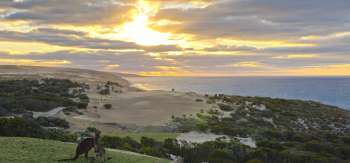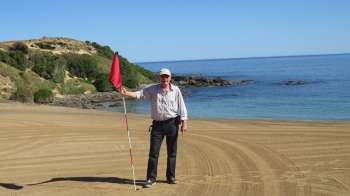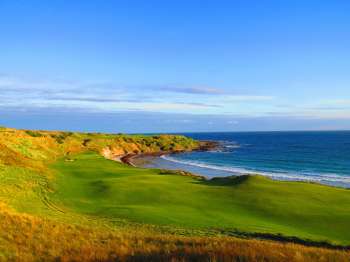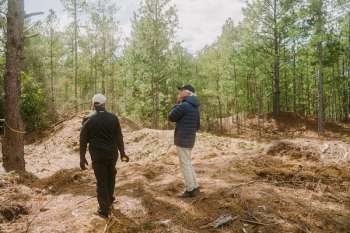Construction starts on the new St Andrews Private golf course
Planet Golf can report that work started earlier this month on the new St Andrews Private Golf Club down at St Andrews Beach on the Mornington Peninsula. Designed by Ross Perrett and Peter Thomson, St Andrews Private will be an invitation only club limited to just 281 people deemed, by the developer, to be ‘Sophisticated Investors or Certified High Net Worth individuals.’
The developers are planning a launch event with Peter Thomson for later this month, but in the meantime are building two show holes and setting up a marquee in order to give prospective members a taste of what to expect from the course. Unlike a traditional membership model, here members will be co-owners of the golf course and the developer has personally guaranteed that each share will be refunded if the course is not built, or fails to open within six months of its scheduled opening date of October 31, 2013. Shareholders will be offered free golf in the meantime at St Andrews Beach.
So the options for those considering joining, therefore, are to wait and see how the course turns out or to sign up now, pay your $90,000 + fee, and start playing the public course next door.
Interestingly, annual fees of $4,900 are also guaranteed at that price for up to three years by the developer in the unlikely event that all 281 shares are not sold.
While October 31 seems an ambitious opening date to us, we wish Ross Perrett and his team well and look forward to reviewing work down on site soon. In the meantime, the article below was written by Perrett and provides a little background on the planning hurdles placed in front of his development team.
Building a new course...where to start?
10/01/2013
Over the coming months, Inside Golf will track the step-by-step construction of a new course at St Andrews Beach to give you an insight into what goes into making a quality golf course.
There are very few new courses under construction in Australia at present. As a mature golfing nation with one of the highest ratios of golf courses per capita in the world, the demand for new courses has waned in recent times, especially given the global financial downturn. One exception is the new course under construction at St Andrews Beach, an hour south of Melbourne on the Mornington Peninsula. It is a bold project, especially given there are currently 28 golf courses on the Peninsula.
To create a successful project it is necessary to tick many boxes including site selection, planning and design, construction, maintenance, marketing and operation. Excellence must be attained in all these areas if the project is to flourish.
In Australia building a new course is not a simple exercise. A planning permit is required before any works can commence and this involves the detailed consideration of many issues relating to State and Local government policies that are constantly evolving over time. At St Andrews Beach the key policies to be considered were legislation relating to Cultural Heritage, Native Vegetation Removal, Green Wedge Policy and a raft of environmental overlays detailed in the local Planning Scheme.
A comprehensive planning submission was prepared that responded to each policy. This was then advertised to over 100 interested parties including abutting neighbours. In order to obtain an approved Cultural Heritage Management Plan (CHMP), specialist archaeologists were engaged to undertake a desktop review of known archaeology sites in the area which was then followed up with an extensive on-site dig. This confirmed the past indigenous occupation on the site resulting in two additional Aboriginal Cultural Heritage Places being registered. Artefacts found during the digs were returned to the site and buried at depth. Representatives from both the Bunurong Land Council and the Boon Wurong people were present during the dig and the reburial of the artefacts. The development has committed to exclusion zones around these recorded sites. In any event the construction of the golf course will require minimum disturbance to the natural surfaces as the design was considered to be very site responsive.
An Environmental Management Plan (EMP) was prepared for the development and describes a set of environmental targets / policies to be met in the delivery of the project. The plan outlines the mechanisms by which the policies can be accomplished, and sets specific criteria by which the degree of achievement can be measured. A comprehensive monitoring programme is proposed and this will address land disturbance and erosion, noise levels, preservation of indigenous vegetation, pest control, cultural heritage sires, maintenance of ground water quality, waste management, fire protection and management, use of chemicals and fertilizers and so on. Specialist consultants were engaged to verify that the proposed activities would meet the required performance criteria. For example, an acoustic engineer has to provide evidence that noise levels from the pump shed would not be excessive (to avoid disturbing the neighbours).
A key trade-off in seeking planning permission for a golf course is the acknowledgement that a golf course will provide massive environmental benefits to the site in terms of the retention and enhancement of the habitat. The site is blessed with an abundance of wildlife that will only be enhanced by the project’s commitment to the restoration of the indigenous landscape. An on-site nursery will propagate over a million plants of local provenance that will increase the biodiversity of the site and be a catalyst for attracting other bird and animal species to the area.
The project has adopted the policies of the Golf Environment Organization (GEO), the world’s peak golf environmental body who promote sustainable golf development and will demonstrate the ripple effects of sound environmental management. The site for the golf course is in an area covered by the State Government’s Green Wedge Policy. This policy is aims to preserve farming land and maintain the rural character of land outside the suburban area of Melbourne which has grown dramatically since the 1960’s. Essentially golf is not a rural activity but golf courses are generally well managed and environments that afford excellent buffers to urban development. The positive contribution golf courses make to our cities was recognised in the 60’s in the Victorian Governments ‘Cultural and Recreational Lands Act. Acknowledgement that golf courses play a vital role as ‘the lungs of the city’ ensured that they are exempted from Land Tax whilst they remain as golf courses.
A vital key to securing planning permission for a golf course is to be able to demonstrate the positive environmental outcomes of the project. In this regard the starting point is to have a site responsive design. In the case of St Andrews Beach this was relatively easy to achieve as the land is ideally suited for the development of a links golf course. It comprises undulating sand dunes of the appropriate proportion with endless variety and requires limited work to render it suitable for golf. The free-draining sand base is ideal for sustaining the desired playing surfaces and will be receptive to the restoration of a productive indigenous landscape. Having received planning consent, the exciting construction phase of the project has commenced in earnest and will be reported on over the coming months.
By Ross Perrett
Back to NewsMore News
The Cliffs Kangaroo Island Announces Preview Play in early 2026
Major milestone for stunning new destination course with preview play available from January 2026
Who Really Designed Cape Wickham Links?
AGD ranks Cape Wickham #1 in Australia & interviews Duncan Andrews to get full story on course design
Cape Wickham Links – The Inside Design Story
Co-designer Darius Oliver reveals the truth behind the design of Australia’s premier modern golf course
Coore & Crenshaw to design new No. 11 Course at Pinehurst Resort
Pinehurst announces that famed design team will design its 11th course on the former Sandmines site




